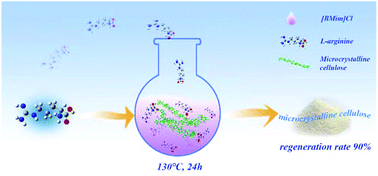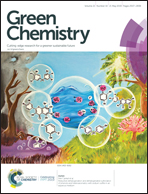Inhibiting degradation of cellulose dissolved in ionic liquids via amino acids†
Abstract
Although ionic liquids (ILs) are efficient solvents for dissolving cellulose, long time dissolution (for example ≥24 h) could lead to cellulose degradation, especially at high temperatures (for example ≥130 °C), limiting the use of ILs in the cellulose industry. On the premise of sufficient dissolution, inhibiting cellulose degradation in 1-butyl-3-methylimidazolium chloride [C4mim]Cl, 1-ethyl-3-methylimidazolium chloride [C2mim]Cl and 1-allyl-3-methylimidazolium chloride [Amim]Cl at 130 °C was achieved by the addition of amino acids. The results show that the cellulose regeneration rate increased from 0.00% to 90.02% at 130 °C for 24 h when 1.25 wt% of L-arginine was added to [C4mim]Cl. It is concluded that L-arginine can form an intermolecular hydrogen bond with one of the three ipsilateral hydroxyls of cellulose, which prevents the cation [C4mim]+ or anion Cl− from simultaneously forming three hydrogen bonds with the three ipsilateral hydroxyls of cellulose, successfully inhibiting cellulose degradation. This work expands the application of ILs in the cellulose industry.



 Please wait while we load your content...
Please wait while we load your content...